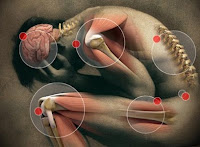Parkinson's Disease Mechanism
Parkinson's disease is a neurological disease.
Achieving Niger locus (nucleus of gray matter of the brain nigrostriatal) leads to inadequate secretion of dopamine (neurotransmitter) involved in the regulation of movements. Dopamine deficiency is the result of the destruction of neurons (nigrities) that usually produce dopamine (dopaminergic neurons).
Historically, this damage leads to decreased secretion of dopamine were highlighted by Trétiakoff in the medical thesis he supported in Paris in 1919, about a century after the first works of PD.
To understand this phenomenon, it is necessary to make small reminder of the neuron and neurotransmitters first. Everyone knows that the brain is made up of tens of billions of cells called neurons, which communicate with each other through a complex network. In other words, each neuron can receive information from thousands of other neurons, and in turn send the information it has received. This information passes from one neuron to another across a joint (that is to say, is to say somehow the junction between two neurons) that bears the name of synapses. For instance, the synapse is the tiny space between two neurons, and nerve impulses must pass. This crossing cannot be done if the first neuron secretes a substance known as a neurotransmitter, which in turn will be recognized by the next neuron, and so on. We described a little more than 50 neurotransmitters. Everyone has heard of adrenaline, noradrenaline, acetylcholine, glutamate and dopamine of course: it is the substance of interest with respect to Parkinson's disease.
Returning for a moment on the black substance within the neurons secrete dopamine. It is therefore, of dopaminergic neurons.
The number of neurons at this level is about 400,000. Knowing that there are tens of billions inside the brain, it is conceivable that this figure is very low.
We now talk about another area of the brain called the striatum. The striatum is part of the basal ganglia of the brain. A kernel is a gray mass of gray cells (usually found at the periphery cerebral cortex) present in the center the white matter, in the manner of seeds embedded in the pulp of an orange.
The relationship between the substantia nigra and the striatum is via extension's cell bodies, which are located within the substantia nigra. In other words, there is a communication between these two areas through extensions of neurons whose body (the main part of the neuron) is located in the substantia nigra.
Each neuron located in the substantia nigra has several thousand endings containing a synapse. In this way, all the information that will happen in the striatum is particularly high given the large number of synapses.
Let's say, the neurotransmitter in the substantia nigra is the dopamine. In reality, the amount of black substance is even more important in the striatum where neurons are extensions of discharge (that is to say, is to say drop) a large amount of dopamine that is accumulated within the striatum.
The number of neurons in the substantia nigra in patients unaffected by Parkinson's disease is about half a million. In Parkinson's disease, this number decreases gradually. At the beginning of the disease, few neurons remaining still can secrete dopamine amount satisfactory to the patient has no symptoms yet intense. However, As the evolution of the disease, these neurons are no longer able to provide, to bring in the striatum, sufficient dopamine which can normally function properly. In the Parkinson's disease striatum, activation has been gradually inappropriate. This dysfunction (malfunction) is not related to the number of receptors in the striatum, as they are in number and quality standard. The problem stems from the number of neurons in the gray matter that it is insufficient and therefore, produces dopamine in an abnormally low amount. If you look under the microscope of the substantia nigra, we see that the number of neurons is very despicable, resulting in pallor of the substantia nigra. This decrease in the number of neurons is not regular. Indeed, there is a part of the substantia nigra and rich neuron while other areas are completely devoid of neurons.
Microscopic examination also highlighted another anomaly. There is indeed the presence of Lewy bodies. Lewy was a neuropathologist which first described these bodies. A neuropathologist is a specialist in neurology that studies the mechanism of onset of certain neurological diseases by observing cells that have failed and, which are most often visible under the microscope. Lewy bodies are small inclusions (foreign) located within neurons spherical for specialists: they are eosinophilic hyaline with a center and surrounded by a clear halo.
It is estimated that the destruction, which is of type apoptosis (genetically programmed death) of neurons is about half before the first symptoms of Parkinson's disease appear. End of life, destruction affects approximately 80% of the stock of neurons of patients.
When neurons were observed phase of apoptosis by electron microscopy, we observed that they exhibit the following modifications. Firstly, there is a retraction of the cell body and condensation and fragmentation (fragmentation) of chromatin (grouping of chromosomes within the nucleus). There are no further alterations of cell organelles such as the endoplasmic reticulum and mitochondria, among others.
Alerts: If you want to know more fresh update helpful articles enter your email address below and be notified by mail.









